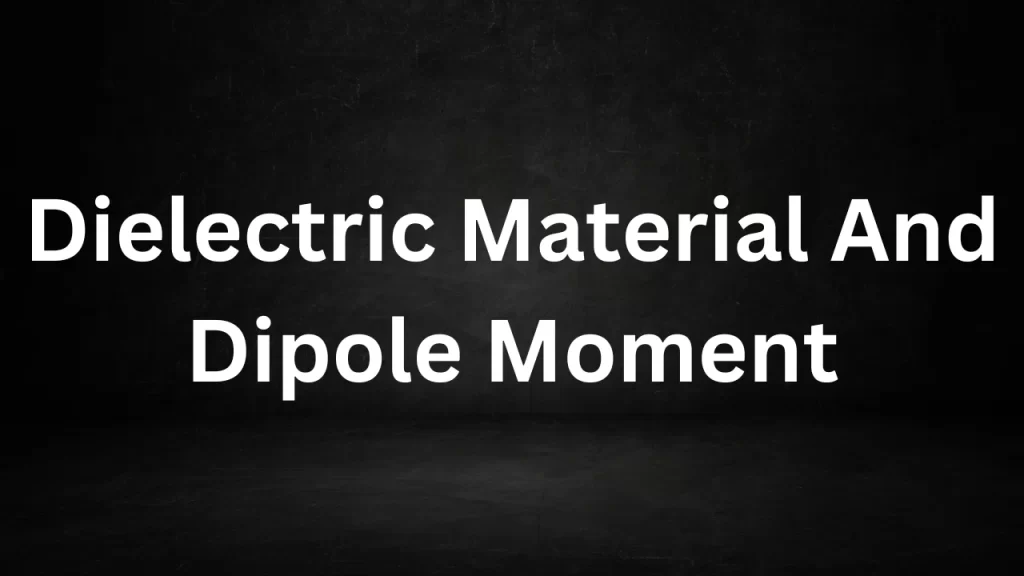Dielectric Material And Dipole Moment: In this piece, we will explore the distinguishing features of polar and non-polar materials.

Dielectric Material And Dipole Moment
Insulators and Dielectric Materials:
Insulators:
Insulators, also known as non-conductors, are materials that impede the flow of electric current. Unlike conductors, which allow the movement of electric charges, insulators have electrons tightly bound to their atoms or molecules.
This strong binding prevents the easy flow of electrons, resulting in a lack of conductivity. Insulators are commonly used to isolate or separate conductive materials, thereby preventing the leakage of electrical current and ensuring safety in various applications.
Examples of insulators include rubber, plastic, glass, ceramic, and wood. These materials are often utilized in electrical wiring, electronics, and construction to prevent unintentional electrical contact.
Dielectric Materials:
Dielectric materials share similarities with insulators, but they have a distinct focus on their behavior in response to electric fields. When placed in an electric field, dielectric materials become polarized, meaning their electrons shift slightly in response to the applied electric field.
This polarization creates temporary dipoles within the material. While dielectric materials hinder the flow of electric current, their ability to polarize in the presence of an electric field is essential in various applications, particularly in capacitors.
Dielectric materials are used to separate the plates of a capacitor, where they store electric energy due to the accumulation of charges on their surfaces.
This stored energy can then be released when needed. Dielectrics increase the capacitance of a capacitor by allowing it to store more charge for a given voltage.
In summary, insulators prevent the flow of electric current by binding electrons tightly to atoms or molecules, while dielectric materials exhibit polarization in response to electric fields, making them valuable for energy storage and manipulation in devices like capacitors. Both insulators and dielectric materials are vital components in modern technology and electrical engineering.
Polar and Non-Polar Molecules:
Polar Molecules:
Polar molecules are those in which the distribution of electrical charge is uneven, resulting in a separation of positive and negative charges within the molecule. This charge separation gives rise to a molecular dipole moment, creating a positive end (where the positive charge is concentrated) and a negative end (where the negative charge is concentrated) within the molecule.
Polarity in molecules is primarily influenced by the electronegativity difference between atoms and the molecular geometry. When atoms with differing electronegativities are bonded, the more electronegative atom tends to attract electrons more strongly, leading to an uneven charge distribution. Water (H2O) is a classic example of a polar molecule, with its bent shape and unequal sharing of electrons.
Polar molecules interact strongly with other polar molecules due to the attraction between their opposite charges. This phenomenon is essential in various biological and chemical processes, such as dissolving polar substances in water.
Non-Polar Molecules:
Non-polar molecules are characterized by an even distribution of electrical charge, resulting in no significant dipole moment. This usually occurs when atoms within the molecule have similar or very close electronegativities, leading to a balanced sharing of electrons.
Examples of non-polar molecules include diatomic gases like oxygen (O2) and nitrogen (N2), as well as hydrocarbons like methane (CH4) and ethane (C2H6). These molecules often exhibit symmetrical geometry, and the electronegativity difference between their constituent atoms is negligible.
Non-polar molecules tend to interact weakly with other non-polar molecules due to the absence of significant charge differences. This behavior is evident in processes like the dispersion forces between non-polar molecules, which contribute to the cohesion of substances like oils and gases.
In summary, polar molecules have an uneven distribution of charges, leading to a dipole moment and strong interactions with other polar molecules, while non-polar molecules exhibit an even charge distribution, resulting in weak interactions with other non-polar molecules. Understanding the polarity of molecules is crucial in explaining a wide range of chemical and physical properties.
Read More
- CBSE Class 10 Basic Maths Question Paper 2020 With Solutions
- CBSE Social Science Class 10 Question Paper 2020 With Answers
- 10th Class All Subject Books Hindi Medium NCERT PDF Download
- Class 10 All Subjects Books NCERT PDF Download in English
- CBSE Class 10 Sample Question Paper Social Science PDF
Frequently Asked Question (FAQs)
What is a dielectric material?
A dielectric material is an insulating substance that does not conduct electric current easily. It exhibits polarization when exposed to an electric field, causing shifts in the distribution of charges within the material without allowing the movement of charges.
How do dielectric materials behave in an electric field?
Dielectric materials become polarized when subjected to an electric field. The electrons within the material experience slight displacements, leading to induced dipoles. This polarization effect enhances the ability of dielectric materials to store electric energy in devices like capacitors.
What is the role of dielectric materials in capacitors?
Dielectric materials are used in capacitors to separate the electrically conductive plates. The polarization of the dielectric material increases the capacitance of the capacitor, allowing it to store more electric charge for a given voltage.
How is a dipole moment defined?
A dipole moment is a measure of the separation of positive and negative charges within a molecule or system. It indicates the strength and direction of the electric dipole created due to the charge separation.
What causes the creation of a dipole moment in a molecule?
A dipole moment arises when there is an uneven distribution of electrical charge within a molecule. This can result from differences in electronegativity between atoms within the molecule, leading to partial positive and negative charges.
